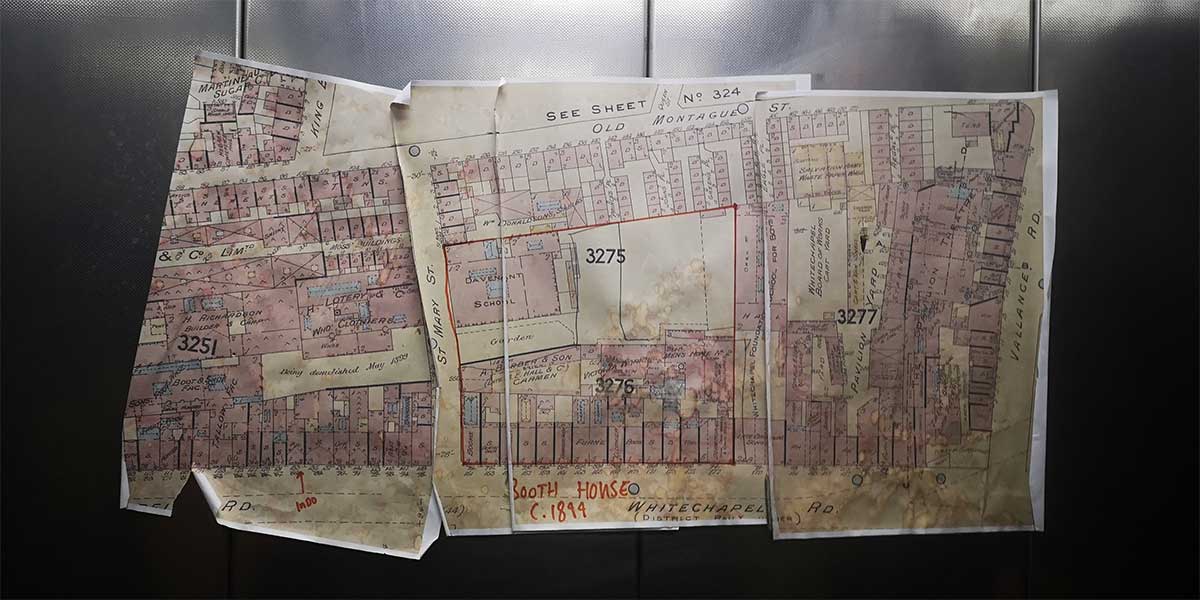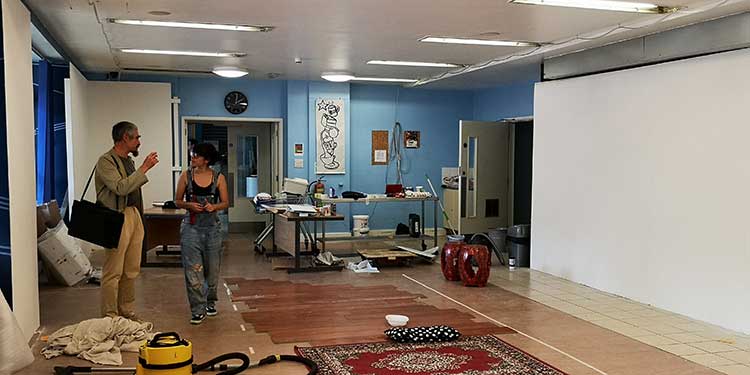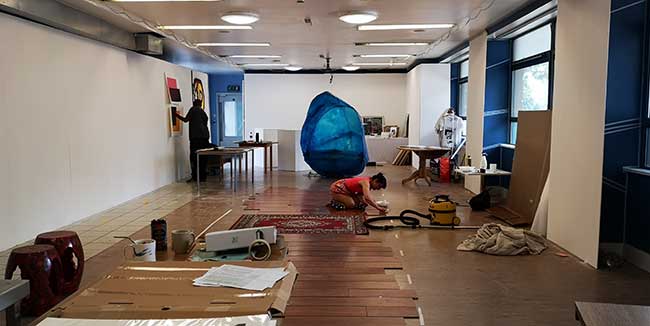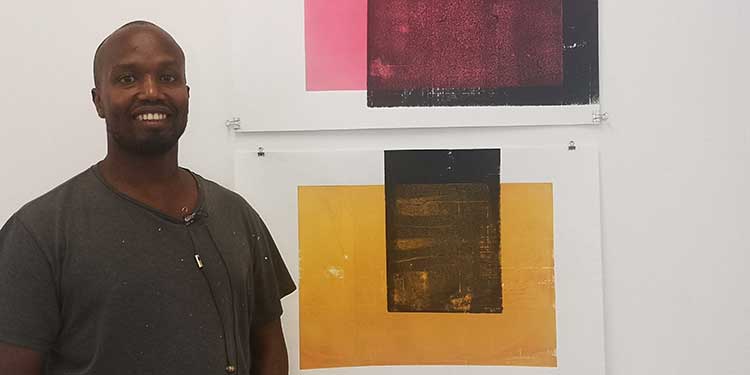
One fundamental question arose upon hearing of the property guardianship scheme at Booth House, Whitechapel. Given that it was purpose built as a Salvation Army hostel (the first edifice on the site in 1844 with replacements & modifications successively opened & reopened by HM The Queen in the 1960s), was how in the present social climate, with homelessness on a steep rise, did it come to be in disuse? The answer was full and forthcoming; the present social climate had put such pressure upon it that managing that amount (the building is extensive & housed around 160 people) of vulnerable and chaotic individuals on a single site had proved impossible or well beyond the resources that could be committed to it. It had pretty much turned feral and become a hub of an antisocial subculture, a liability to the public and was on its way to generating exactly the kind of problems that it originally set out to address.
The Salvation Army still owns the building and (presumably) utilises some portion of the revenue obtained from rents paid by the current guardian occupants to further its work on other sites while providing relatively affordable accommodation within the metropolis.
That this body of approximately ninety guardian tenants includes many creative practitioners; artists, designers, writers and musicians, for whom affordable space, to both live and make their work is a perennial issue highlights a further social consideration addressed by the overall initiative.
Much (or all?) of the work undertaken brought the buildings from the parlous state in which they had been left to a condition both habitable and now capable of hosting such a remarkable exhibition: BOOTH HAUS has been undertaken by the guardians themselves since they took up residence. Their efforts and occupation have occasioned significant expressions of appreciation from members of the immediate locale and the passing public.
An important condition of their residence – and from speaking to occupant exhibitors, a meaningful motivation which seems in many cases to underpin their artistic output – is that they are engaged in some form of voluntary work in the broader community.
In discussion with a number of these exhibitors it became apparent that many were highly, formally qualified and to different extents (up to Masters & Tate Modern exhibition levels) established in their respective fields, but feeling that in many ways the BH/BH collaboration was providing the support that if not completely lacking on contemporary academic art & design programmes, could have been much greater. An overview revealed to this observer that it was providing precisely what seems to be lacking in many contemporary institutions: a true sense of collegiality.
There is no sense of subscription (or indeed conscription). This is not some overarching commune bound by formulaic ideals, rotas or that upon which one’s great aunt at a family gathering as the piano lid went up, would comment disdainfully ‘Oh! and now for the enforced enthusiasm!’ There is both freedom of practice and variability of an individual’s involvement in the collective.
As one exhibitor (Rupert Earl, kinetic/light/sound installation) said:
‘The experience (living/working at Booth House) is very conducive to the creative path, to be supported by the knowledge of being among others who have that space, both physically and in their lives and the will to make work. Not necessarily in any explicit way though there is a great deal of material support but by association (something almost sensed), a perceived latent drive within the group and the building’.
Beyond this he also placed particular value upon the opportunity for the overview of the works and concerns of his co-exhibitors and other resident practitioners, and for the sympathetic environment for his transition to independent practice from the university setting (Contemporary Media Practice, University of Westminster, 2018).
With a background in live video performance, a passion for film & film making he seeks a more immersive experience beyond the frame of the screen. Here his installation The Waiting Room, a response to the space’s prior designation as Booth House’s Boardroom explores notions of limbo evoking a transient ambience with projections & reflections, diffractions & interference and shadows cast by suspended, out of scale, skeleton models of objects and furniture.
Transition in various forms surfaced several times in these works and conversations. Oscar Lewis’s vigorous expressionist portraits (oils, mixed media) represent a personal, natural transition from the animation (hand painted cells/glass) with which he graduated (MA. RCA. 2016) and with which he worked commercially to form a fundamental focus on painting as his major output. For this he now seeks projects/a future as a more traditional patronage-based exhibiting artist.
He further highlighted the transitional experience of Booth House as being that which naturally attracts artists/creative practitioners. A sense that rather than striving for future goals or objectives the prevailing mood was developing or adaptive, a seizing of This Day, These Interactions, This Opportunity, This NOW.
This is perhaps a major underlying factor which promotes the obvious sense of artistic fertility and vitality of expression – this lack of external constraints or the self-styling which ultimately limits any expression but with nonetheless the degree of confidence and encouragement to experiment beyond one’s comfort zone. These almost ambient qualities seem also to be held in especial esteem by those who do not necessarily have a prior background in artistic practice or study:
Frankie Cole, Interior Designer, says that taking up her profession is a direct consequence of her residence at Booth House. Here individuals have the freedom to change/decorate their living spaces as they determine by stark contrast to modern conventional tenancies with their magnolia stipulations & thumb tack phobia. She believes that ID should not be a prerogative of wealth, that all should be able to determine and experiment with their environment to suit their needs and tastes; that the role of the designer is supportive, that facilitating their self expression not didactic or imposing of any grand design or scheme. Affordability is in great part achieved through her preferred use of re/up cycled and salvaged materials, with some emphasis on ideas of aesthetic repair where that which may be conventionally perceived as flaw or fault is deliberately enhanced to become a distinguishing feature or an expression of the individuality of an object or design. Frankie is responsible for the central lounge area in the gallery and she will be conducting tours during the course of the exhibition of the rooms and spaces that she has treated for residents. Of the development of her practice at Booth House she says
‘Key is the supportive atmosphere and encouragement which advances individuals with a momentum that it would be difficult to muster solo’
Jooles Elmsley, who is acknowledged by the group as a central motivator for the whole initiative (BH/BH), similarly acknowledges his association with other residents/practitioners as the major motivation to pursue, develop and extend his own practice as a freelance photographer. Working as a cabin crew member for airlines on a month on, month off basis to fund his work he also has the opportunity to document life scenes from many locations across the world. His black/white photographs evidence an eye for inherent drama in the unselfconscious activities of those who are about their lives and business. Sensitive and emotive lighting and a keen sense of contrast has led him to abstract formal concerns from the documentary to a number of wall mounted reliefs. Tactile or suggestive of tactile experience they explore and evoke ‘contrasts in life’, tensions between depth and surface, light & dark, hard & soft, the reflective & the absorbent. He seeks a minimal expression which nevertheless remains a target for an emotive response.

Self taught and widely informed through travel he acknowledges the influence of the works of established artists and masters, past and present and has a keen awareness of their influences upon and associations with each other. Citing that this was often due to their living in proximity forming natural schools, movements and groups he was quick to identify that similar dynamics existed among the creative core at Booth House and actively seeks to foster a loosely formulated collegiality (and here it is explicitly articulated as such) of mutual development and confidence among collaborators as equals. To this end and placing himself and his workshop at the service of his co exhibitors he has undertaken a great deal of the physical construction for this project.
Mai Sanchez (Exeter College / Plymouth University) is graphic artist whose prints, paintings & drawings demonstrate a light humour and whimsy that immediately engages. There is, however, the impression of some further depth which beckons one into a world of visual pun and questions initial perception. This she achieves through the confident command of her medium; strong figuration, the particular use of colour and the formal relationships within an image. The viewer is literally captivated, placed in the midst of the image by her compositional dynamics.
Mai is the group’s designated curator and point of contact for external liaison and has been responsible for the overall planning & hanging of the show. Her objective for the project seems characteristically simple: That the group should function, at all levels, to push the individual to greater endeavours and as far as possible assist and facilitate them. The touch may be light but the overall conception does acknowledge the need for a collective identity. The choice, it would appear, has been made to allow the show itself, its collective presence and the manner in which it occupies its space to fulfil this and thus to dispense with any need for additional or more binding agenda.
Rob Ngare is a graphic designer (Graphic Media Design, LCC. Elephant & Castle), specifically for posters/covers for plays by Samuel Beckett. These are essentially the colourfield backwork without the bold typography that they were designed to support. Thus abstracted they serve, for those who know the plays, as ambient meditations, with characteristic minimalism
‘..to reflect the plays using basic shapes, tones, textures..’
and of their players;
‘.. two characters, two shapes, two colours.’
There is here, too, a sensitivity to the design idiom of the period of Beckett’s popularity. This is effective graphic expression through evocation at two levels; designed to communicate simply and directly with an informed public while beguiling with a gentle nostalgia that is in itself entirely contemporary.
Rob is also responsible for security at Booth House and as ‘guardian of the guardians’ he necessarily interacts with all of the residents. He has come to value the dialogue and collaboration with this group, this particular opportunity to view the work of the other participants and to see how his own interacts in the exhibition. His personal aim, put disarmingly simply
‘to pleasure the eye’
couples neatly with his view
‘Any space is potential exhibition space.’
Danae Natsis, jeweller (Jewellery & Object Design, Advanced Diploma T.A.F.E. prior degree: BA (hons.) Fine Arts, University of New South Wales) has been living in London for two years. Her work is concerned with ‘colour on / colour from metals’ and elements of random formation via process (hammering; direct beating & repousse, folding, wrinkling & abrasion). They suggest associations with and to some extent draw inspiration from, the organic, globular forms found in marine life and creatures. Her preferred medium, anodised Niobium, is heated, pattinated and abraded successively and repeatedly to produce an object of intense and varied iridescence which is as much a focus for the eye as any gemstone. She is here showing a range of her smaller informal pieces.
With previous experience living as part of a utopian community with caretaker leases in abandoned buildings in Sydney, Danae places no little importance on living in affordable accommodation among like-minded people. She specifies the importance of communal space and the interactive opportunities afforded by the building (Booth House) and its occupants. She acknowledges the value of the voluntary stipulation ‘the dickhead filter’ in underpinning the ethos of the community (she volunteers for The Salvation Army gardening service & at Stepney City Farm, where she recently helped deliver piglets).
Momentum for her artistic practice (again explicitly cited), derived from living among active creative practitioners along with this opportunity to exhibit in London, is high on her list of the personal benefits of her residence and participation.

Mushroom xmx.luo, graphic designer & illustrator, is exhibiting a series of AR animated illustrations entitled A Little Adventure. Light and gentle to the eye these are highly graphically resolved digital prints which, through the manipulation of the digital layers, are capable of becoming animate when viewed through one’s ‘phone or similar device. Her premise is of an explorer reduced to microscopic scale on expedition among fauna & flora that may be otherwise unregarded or trodden underfoot. Fungi and flowers tower above the diminutive heroine like mighty oaks as she proceeds through the title stages ‘Searching’, ‘Navigating’ & ‘Preserving’. These represent Mushroom’s concern for conservation and her commitment to raise public awareness of not just the major world causes but also of the world at our feet. She volunteers for ‘Animals Asia’, has worked with projects in China rescuing & rehabilitating bears that have been used in pharmaceutical production, and recently designed a series of postcards of endangered species in China. She will also be showing her sketchbooks at Booth Haus. She values the sense of community and security at Booth House and the support that she receives ‘without any pressure to be more involved than she would be’.
Michelangelo Arteaga (MA. Fine Art Chelsea College of Arts 2014) is a passionate and confident sculptor who is not afraid to confront some of the fundamental issues & questions of human existence and survival in both the philosophical or psychological abstract and in the context of contemporary metropolitan living.
His piece, Spiral of Life provides a helpful substantial focus for anyone upon first entering the gallery. It is an easily identifiable presence or point of reference from which to circumambulate the exhibition. Previously exhibited at Tate Modern 2018 & St Paul’s Cathedral 2017 with its two companion pieces, it is a bold move to install it here where it must necessarily interact with other works in proximity in a venue with street level access. Interaction, particularly with the public would seem to be of some considerable importance to Michelangelo. Constructed in resin, in discrete sections subsequently nested and fixed, it imitates the iconic shell of Nautilus Pompilius with its Fibonacci spiral but is here confronted on a scale that might encourage one to enter bodily. This compulsion is further compounded by the heartbeat (Michelangelo’s own) issuing at just above audible level from beyond its inward curve. There is the feeling that one could be led, descending inwards forever.
Somewhat lighter, superficially less daunting in scale at least, is his playful articulation of our choices in a bewildering world – The Chocolate Box, a set of small intricate netsuke like bronzes resting in a Tyrian velour lined hardwood box. Lovingly crafted and with the customary map of contents; single words & phrases for flavours, a key to one’s emotions and longings and an invitation to select first and consult afterwards, to taste & see.
This is a minimalist statement in the sense that the term was originally applied before it was appropriated by a more contemporary clinicism and demonstrates a clear lineage from such works as Robert Morris’ I and Box With The Sound of Its Own Making. Michelangelo confirms that (re)tracing lineage is something that concerns him (it has surfaced too in other conversations with artists here); that mainstream contemporary exhibitions & Art often appear to only speak to themselves or their initiates, that public engagement with works is often disregarded or limited to something passive, leaving it and ultimately the artist feeling bewildered and short-changed, a concern to track back to stations before those of false departure, a quest for the rediscovery of something vital, a search for the last points of meaning and a reclamation of a viable visual vocabulary (& a sense of humour!) that was intelligible to all.

There is some sense too of all these considerations, with regard to art, to politics and to society in general, hovering at the back of his lateral visual pun, a response to UK Brexit, The Pen is Mightier than The Sword where an anvil is apparently crushed beneath a feather.
There is a palpable sense throughout the whole of this exhibition that all of the participants are on a journey. Analogous perhaps, in traditional (now almost archaic) terms, with ‘The Journey’ that upon which proven artists or craftsmen, would embark as Journeymen in the field to establish their renown. This opportunity to appreciate the varied achievements of so many, living and working under the one roof, seems just cause for celebration indeed.
Felix Zakar, 2019
Images by Keith Rodway
